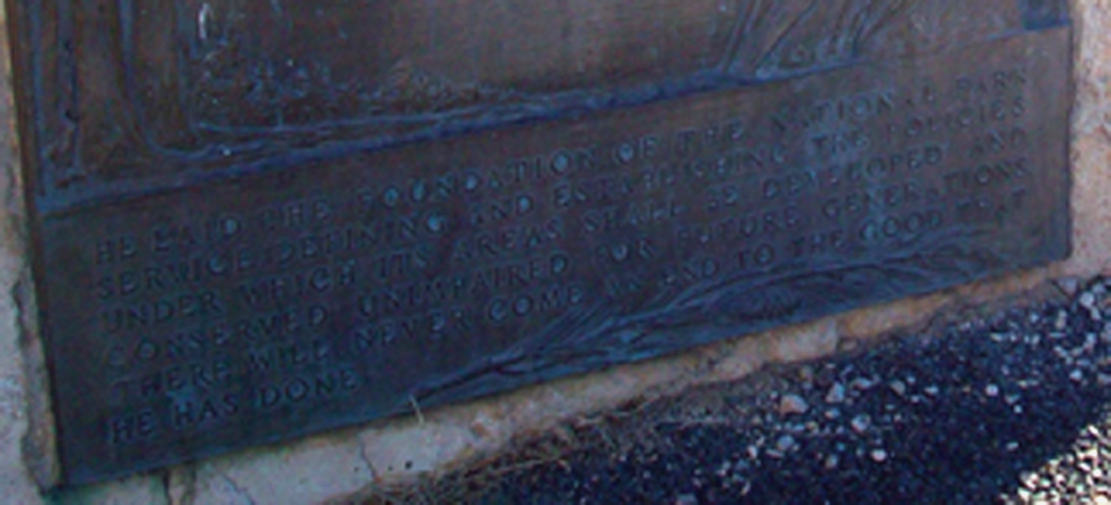 |
 |
The very setting aside of the cave's natural landscape for public viewing (whether formalized as a National Monument or not) is an enactment of visual materialization, and cultural shaping. As Mitchell points out, "the landscape (in all its senses) is both an outcome and the medium of social relations, both the result of and an input to specific relations of production and reproduction. In our world, the landscape (again in all its senses) is a commodity. This is perhaps especially so in the case of landscape as a representational art and architecture" (2005, 49). When landscapes are commodified to capitalize on their aesthetic representations, development is done with a specific eye toward this cultural shaping. In speaking of Yellowstone's development as the first national park, Corbett acknowledges that "early park architects helped to develop an architectural language that spoke of the conservation of nature and at the same time constructed wilderness as a place of leisure" (2006, 141). In discussing the work of Stephen T. Mather, Founding Director of the National Park System, and his assistant Albright, the National Recreation and Park Association speaks of the two as just such architects. "By opening up the parks to the public at large, they made the Park Service an agent of modern society; they provided America with the Great Destination as the annual vacation became part of the rhythm of its life. By resisting resource exploitation in the parks, they became heirs to ... the preservationist wing of the conservation movement" (www.nrpa.org/admin/content). Mather's epitaph, summarizing these ideals and cast in bronze, is found at the entrance to Carlsbad caverns.

As Martin says of outdoorsman, "Hikers, backpackers and the like are viewed as rugged, health conscious individuals with an intense, almost reverent bond with nature" (2004, 518). But in addition to the healthy adventure opportunities offered by wilderness as leisure, "vacations to natural areas also fit our notion of nature as a refuge and sublime landscape, worthy of Kodak moments. Our national parks are good examples of our aesthetic and social preconceptions of what's beautiful and awe inspiring" (Corbett 2006, 136). The cave's expression of the sumblime and the longevity of cavern formations especially seem to mobilize Corbett's dichotomy of conservation interests cohabitating with leisure activity. In this manner, caverns seem well-suited to capitalize on all three of the "tourist gaze" types expounded on by Urry, who categorizes objects of the gaze "in terms of romantic/collective, historical/modern, and authentic/inauthentic" (1990, 135). It may be argued that these three gazes parallel the binary subjectivities of the cave visitor: the aesthetic (collective) artist, scientist/environmentalist and the tourist-explorer/discoverer. Urry points out that "different gazes and hence different tourist practises are authorized in terms of a variety of discourses" which may include education, enlightenment, group solidarity, health and play (ibid) - singly or in combination.
As the American middle-class expanded and travel became easier and more affordable, caves across the nation gained prominence as tourist sites. Cave "promotion campaigns started mainly at the end of the 19th and beginning of the 20th century. Just as they are today, distinctive characteristics of each cave were promoted. They were described using fairly standard and similar superlatives. Each cave had the 'highest room', 'longest river' or 'nicest stone formation'" (Diekmann, et al. 2006, 274). Each cave wanted to claim its position within the 'extraordinary', and mobilize its civic functunalities. As Halliday the golden age explorer said of Carlsbad Cavern, "Nevertheless, this cave stands alone. No person has really lived until he has visited it. No caver knows caves until he has viewed its features. Come and see for yourself what Jim White found!" (1959, 136).
Cave owners were quick to recognize the necessity of commercialization as preservation from the destructive effects of unaccompanied, untrained travelers-tourists. Orion Knox is credited with encouraging Jack Burch (who also commercialized the Caverns of Sonora) to commercialize Natural Bridge Caverns after discovering the extensiveness of the cave. Knox says of his decision to interrupt his education to help, "I agree with Jack Burch's philosophy that the best way to protect a world-class cave is to commercialize it, then make sure it is operated right and protected for future generations" (Pittman 1999). In "Adventure is Underground," Halliday likewise applauded commercializing Carlsbad Caverns. "Despite the inevitable commercial appearance of the Lunch Room, which must make many a sensitive visitor shudder slightly, most of the great cavern still retains its pristine beauty for scientists to study and for future generations to enjoy. What an enormous debt of gratitude America owes the National Park Service for its preservation of her greatest beauties!" (1959, 133).
[ Back ] | [ Continue Tour ] |